► The best superminis you can buy in the UK in 2024
► CAR magazine’s guide to buying a top new supermini
► From the affordable Sandero to the stylish new Clio
Though some may have fallen by the wayside in favour of bigger SUVs, a few surviving superminis can still hold their heads high as some of the best new cars on sale today. These small cars offer an excellent blend of a small and manageable footprint, low running costs, good driving dynamics and impressive practicality, helping them tick lots of ownership boxes with minimal fuss.
Okay, so perhaps they’re not so small as they used to be; the current Ford Fiesta has roughly the same footprint as an original Focus, for example, and a new Volkswagen Polo takes up as much Tarmac as a fourth-gen Golf. This ramping up of scale has helped drive their popularity in the best new cars lists, with buyers downsizing to more affordable-to-run cars that are now upsized and capable of tackling their daily needs.
The best superminis 2024 at a glance
So, what is a supermini? This peculiarly British expression – Americans prefer ‘subcompact’ – refers here to B-segment cars, or small cars. Our sister site, Parkers, defines one as ‘a relatively small, cheap and economical car. Larger than a city car but smaller than a family hatchback’. And the past two decades have seen the supermini sector expand and diversify; first, the Mini introduced premium-style personalisation, then the Nissan Juke launched the compact crossover – a bandwagon others swiftly piled aboard.
Lately, there’s a new breed of small all-electric superminis: still niche for now, but certain to swell in popularity as costs come down. All told, there’s a lot of choice, so we’ve put together a guide based on our comprehensive tests, and CAR magazine’s long-standing GBU – the Good, the Bad and the Ugly – data section, to help you quickly and easily choose the best new supermini to suit you needs.
Best superminis in 2024
Renault Clio
A stylish, swift and sensible option
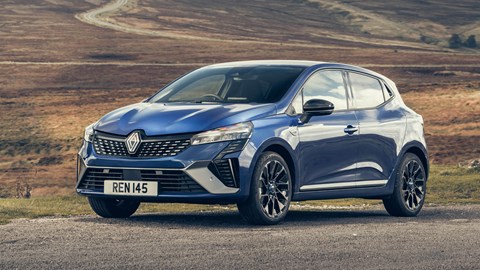
Pros: Smart interior; good tech; efficient powertrains
Cons: Can get expensive; trades rear room for boot space
A girlhood crush, a teenage tryst, a sham marriage and a tearful reconciliation. Renault’s ‘30 years in the making’ Clio ad (look it up on YouTube) pushes boundaries and tugs at heartstrings. The car itself is more conventional, with same-again styling that lacks the flair of French rivals. Still, you can’t blame Renault for playing safe with its best-seller, and the fifth-gen Clio is a step-change for quality, connectivity and driver assistance tech. Like our 30-year-old heroine, it’s grown comfortable in its own skin.
Inside, the standout feature is a digital driver’s display and prominent infotainment system, which comes with wireless Apple CarPlay and Android Auto – an essential feature for many buyers. The Clio also offers a best-in-class 391-litre boot, and a good choice of efficient powertrains, including a hybrid option. Feelsome steering and a fluent ride make the Clio fun around town, too, but there’s no evidence of any Renault Sport alchemy yet.
For a more in-depth look read our Renault Clio review
Toyota Yaris
Frugal, durable, and surprisingly good fun
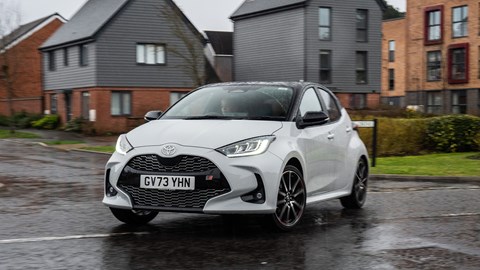
Pros: Good driving experience; low running costs; neat styling
Cons: Ride can be a bit busy; drab interior; not as keen as a Fiesta
Previously, the Yaris was a little dull and unlikely to snag the attention of many a buyer. This latest iteration, however, is a far more attention-grabbing car. It’s more stylish, quicker, packed with kit, easier to live with, and much better to drive; it might not have the outright dynamism of a Fiesta or Mini, but there’s still lots to enjoy here. It’s also one of the best automatic options around, with a responsive and quiet e-CVT system.
You get a lot of equipment for your money, too, with the base Icon mode including adaptive cruise control, Apple CarPlay and Android Auto connectivity, a reversing camera, climate control, and automatic wipers. Crucially, if you get it serviced by an approved Toyota repairer, the Yaris will also benefit from a ten-year, 100,000-mile warranty. Couple that with Toyota’s high standards of reliability and you’ve one seriously low-fuss runabout. And, of course, there’s always the GR Yaris if you want something spicier.
For a more in-depth look read our Toyota Yaris review
Hyundai i20
Sporty N variants are ideal for enthusiasts
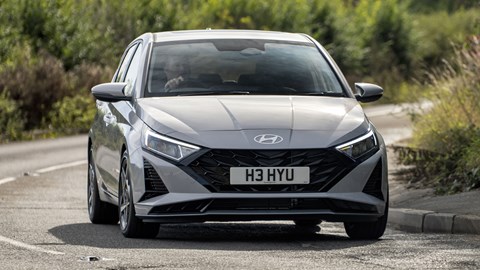
Pros: Sharp styling; great i20N and N Line models; lots of equipment
Cons: No diesel or electric options; firm ride; basic variants are a bit dull
There’s a lot about the i20 that makes it a sensible purchase. You get a five-year warranty, it has good residual values, the finance deals are good, running costs are low, and it comes with a lot of equipment out of the box – including cruise, parking sensors, Apple CarPlay, and LED headlights. In standard form, however, it’s a bit dull to be in and drive.
But, and why it earns a spot on our list here, there are two hotter variants that are much more interesting: the i20 N Line, which has a 118bhp 1.0-litre turbocharged mild hybrid powertrain, and the high-performance 1.6-litre 201bhp i20N. The latter competes directly with the Poo GTI and Fiesta ST, so if you’ve been seeking a higher-performance supermini, it’s well worth investigating.
For a more in-depth look read our Hyundai i20 review
Skoda Fabia
Compelling Skoda is a great all-round option
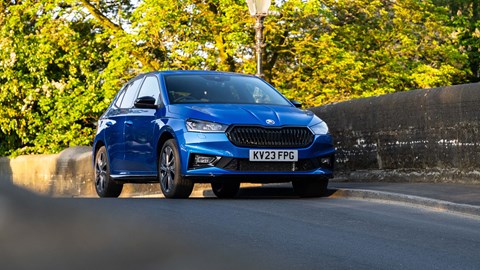
Pros: Practical and spacious; efficient engines; refined ride comfort
Cons: Lacking in charm and fizz; only petrol options available
We’ve a lot of time for the Skoda Fabia, as does our sister brand Parkers – which voted it the Best First Car for 2023 in the Parkers New Car Awards. It shares much with its Group counterparts, the Volkswagen Polo and SEAT Ibiza, but it’s typically cheaper than either. However, it doesn’t do this by skimping on quality; it feels just as finely finished as its rivals, making it the go-to option if you’re not otherwise fussed about badge or appearance.
Practicality and space are also big strong points, and the Fabia’s also worth considering if you’re looking for a small hatchback that’s comfortable and refined. You should draw a line through it if you’re after something fun to drive and exciting, though, as it trails the Clio and others in its field in that area. Alternatively, take a look at a Seat Ibiza if you want something similar but sharper and more stylish.
For a more in-depth look read our Skoda Fabia review
Peugeot 208
Characterful Peugeot offers plenty of choice
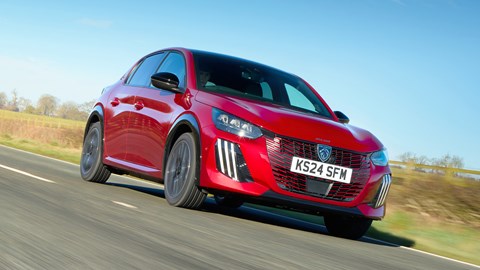
Pros: Snazzy design, inside and out; good array of tech; efficient
Cons: Not as fun to drive as a Fiesta; refinement a little lacking
The 208 looks like an ‘homage’ concept car with number plates. Pert and perfectly proportioned, it riffs on the classic 205 – it’s all about that C-pillar – without resorting to pastiche. See one in the metal and you’ll be half-way to a PCP contract. The interior is more avant garde, with 3D ‘hologram’ dials, tactile piano key switches and subtle ambient lighting, plus build quality to make a 205 owner weep.
What’s also appealing is the array of choice; buyers can pick from electric, hybrid or petrol versions, in an array of well-equipped trim levels. Twirly, over-assisted steering, a vague manual ’box and a brittle ride mean the 208 is mildly underwhelming to drive, especially when compared to the likes of the Fiesta, but if you’re sold on the styling and tech, there’s much to enjoy here.
For a more in-depth look read our Peugeot 208 review
Dacia Sandero
An affordable and pleasant family hatch
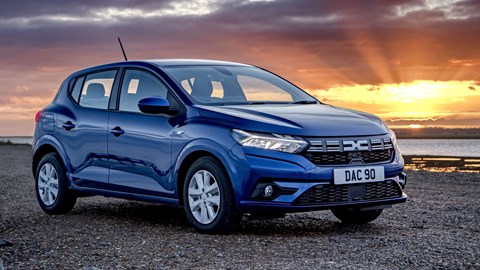
Pros: Great value; decent amount of space; does what it needs to well
Cons: Cost-cutting evident in places; poor Euro NCAP score might bother some
The Sandero might not be as inexpensive as it used to be, but it’s still one of the best-value-for-money cars out there. The basic Essential version starts at £13,795, for example, which undercuts myriad rivals by several thousand pounds. Even that comparatively low price, you still get features such as cruise control, air conditioning and Bluetooth connectivity, as well as a decent TCe 90 petrol engine.
Its appeal goes beyond equipment and cost, though; it’s a bit bigger than some rivals but it subsequently serves up a lot more interior space, and a big boot, and its interior is comfortable (albeit just functional, rather than anything more impressive). It’s also decent to drive, with a good ride quality, so it won’t just be your bank balance that appreciates it.
For a more in-depth look read our Dacia Sandero review
Honda Jazz
Sensible runabout majors on practicality
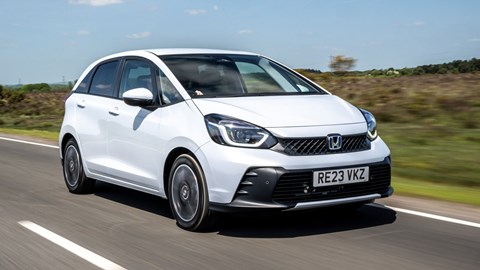
Pros: Practical and spacious interior; excellent reliability; pleasant to drive
Cons: Only one engine option; can feel a bit cheap and noisy
If you need a versatile and dependable small car, one that packs maximum versatility into something with a compact footprint, make a beeline for the Honda Jazz. It’s got stacks of room inside, it’s well built, neatly finished, and it’s reliable and frugal – the latter being thanks to its effective hybrid powertrain.
The Jazz is also an easy car to drive, with good visibility and light steering, but it’s also surprisingly good fun to drive as well. This marks a big change from previous fine-but-dull iterations, and makes the Honda far more worthy of consideration. It can feel a bit cheap in places, though, but if you value practicality and cost of ownership, you’ll probably be willing to put up with the odd bit of noise or low-rent plastic.
For a more in-depth look read our Honda Jazz review
Volkswagen Polo
Solid and straightforward Polo is easy to live with
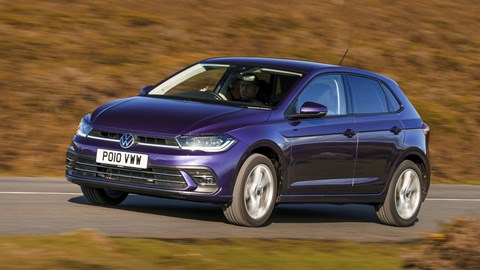
Pros: Refined driving experience; good interior space; quality tech
Cons: Little fun to be had; can look very dull; limited engine line-up
Lacklustre GTI excepted, the Polo distils what’s good about the Golf into a smaller, more affordable package. Of all the superminis on sale, it’s the one you could imagine owning until its wheels fell off, rather than chopping in every three years for the Next Little Thing. In truth, the Polo feels no better built than a Clio or 208 – how times have changed – but its unobtrusive design and affable road manners take time to earn your esteem.
Most buyers go for the 94bhp 1.0-litre TSI petrol, which is a smooth and refined engine. The chassis feels rather disinterested, although the GTI – which gets Adaptive chassis control and sports suspension – is appreciably sharper. Inside, the Polo accommodates four adults and 351 litres of luggage, plus you can opt for digital instruments, brightly coloured dash panels and a Beats audio system. Too jazzy? A plain Polo will do you just fine. At that point, though, you might be better off with a less expensive Skoda Fabia.
For a more in-depth look read our Volkswagen Polo review
Mini hatchback
The new hatch is still great fun
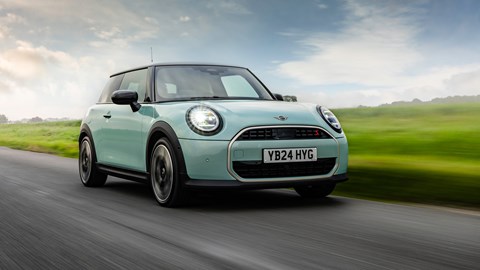
Pros: Enjoyable to drive; lots of personalisation options; impressive performance
Cons: Can get expensive; rough ride on big wheels
Compare the fortunes of Smart and Mini: while Mercedes’ small car has floundered in the past, BMW’s has flourished. Bold design and clever marketing – including never-ending options for ‘personalisation’ – mean Minis are somehow both youthful and fashionably retro. However, only the three-door Hatch is truly supermini-sized.
We’d go for the 201bhp three-cylinder Cooper – not enough to blow the bloody doors off, granted, but you could see a real-world 40-50mpg. Besides, the Mini is a born entertainer. Taut and tenacious, it changes direction like a terrier chasing a tennis ball. Flick to Go Kart mode and the central screen promises ‘Maximum go-kart feel’.
For a more in-depth look read our Mini Cooper review
Supermini buying guide
Think about your requirements first. If most of your driving is around town, one of the best new city cars – such as a Fiat 500 – may fit the bill. Trading down from an SUV? You might enjoy the loftier driving position of one of the top new crossovers. Don’t assume everything SUV-shaped is more practical, though: larger wheels and longer-travel suspension take up valuable space.
The majority of best hatchbacks now have five doors, but there are other considerations if you have children to carry. Can you fit child seats in the back and are there Isofix mounting points? Is the boot large enough for a buggy? And how does the car fare in Euro NCAP crash tests? Lower-spec models may be missing active safety equipment, which reduces their star rating.
Despite the move towards EVs, petrol power is still the default here. Modern turbocharged three-cylinder engines are impressively punchy and efficient. We’d think carefully before paying a premium for diesel, especially with the prospect of more cities emulating the Bristol ban. As for hybrids, they’re an increasingly common and tempting option, blending refined power delivery with impressive economy.
Best superminis of 2024: FAQs
What is the best supermini on the market?
There are lots of great options if you’re shopping for a new supermini, but we rate the new Renault Clio the best out of the current bunch. It looks great, it’s comfortable, accessibly priced, it’s well equipped, and it’s good to drive. The recent facelift and introduction of the E-Tech hybrid version has only bolstered its appeal.
What is the fastest supermini?
There are a lot of supermini-based hot hatches out there that offer serious performance. The Mini John Cooper Works, for example, can hit 153mph and accelerate from 0-62mph in 6.1 seconds. If you can get your hands on one, there’s also the all-wheel-drive Toyota GR Yaris; it has a slower claimed top speed of 143mph but it is quicker, dispatching the 0-62mph dash in 5.5 seconds. Ford’s Fiesta ST is also capable of 143mph, but its takes 6.5 seconds to complete the same benchmark sprint. The Hyundai i20N is another strong competitor in the hot small car class, hitting 142mph and sprinting from 0-62mph in 6.2 seconds.
What is the difference between a hatchback and a Supermini?
A supermini is a type of car that is smaller than a regular family hatchback, but larger than a city car. Take the Skoda Fabia, for example; it is bigger than the Skoda Citigo, the brand’s compact runabout, but it is smaller than the Octavia hatchback. It’s a similar story with the VW Polo; it’s bigger than the Up, but smaller than the Golf. This means that superminis are ideal for those who need a bit more interior space, for carrying passengers or luggage more regularly, without the higher running costs and larger footprint of a regular hatch.